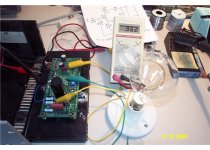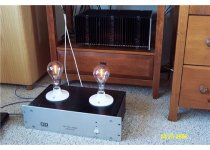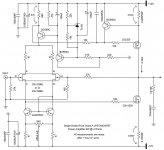Fella, if you would kindly tell me where I could find film caps of that size, I'd be grateful. Translate that as, yes, electrolytics are the order of the day. (Of course, you could always bypass them with film caps.)
Yes, C1 can be more than 10,000uF. It will lower the low frequency cutoff point. More bass won't really hurt your feelings, will it?
Loser?
Nope.
What have you lost?
Nothing.
You're about to gain a nice amp...and there's nothing wrong with that. Look at it this way--I've got two ideas on the front burners and a half-dozen in reserve in case one or both bomb out, but I'm not able to listen to them yet. You'll be listening to music through these JFETs before I do.
Grey
Yes, C1 can be more than 10,000uF. It will lower the low frequency cutoff point. More bass won't really hurt your feelings, will it?
Loser?
Nope.
What have you lost?
Nothing.
You're about to gain a nice amp...and there's nothing wrong with that. Look at it this way--I've got two ideas on the front burners and a half-dozen in reserve in case one or both bomb out, but I'm not able to listen to them yet. You'll be listening to music through these JFETs before I do.
Grey
Thanks Grey. Actually I fooled myself! Boy, I guess this was too simple.
On my list of caps was C1A which DOESN"T EXIST! I now realize it was a 10 mfd bypass cap that I invented and added to the purchase list. I was then apalled that the local electronics emporium didn't stock any poly caps in that value. Of course you are right, a 10,000MFD poly would probably be the size of a garbage can in a decent voltage! It was the 10 MFD (not on schematic ) that I was hoping to get in a poly.
The store was NOT R. Shack, but a moldy old storefront that should have been a treasure trove of reasonably priced goodies. They only stocked ONE brand of metal film resistors (Xicom of course) All the stock was old and the leads were corroded-BUT, instead of paying surplus prices they wanted top dollar. When they wanted $29.95 for a 10,000 MFD no name 60v electrolytic I politely paid for my resistors and walked out, figuring that the 30,000mfd 63 v. caps I have at home (that I paid $6 for online) might do the job!
So, I guess I did the right thing- thanks for the help.

On my list of caps was C1A which DOESN"T EXIST! I now realize it was a 10 mfd bypass cap that I invented and added to the purchase list. I was then apalled that the local electronics emporium didn't stock any poly caps in that value. Of course you are right, a 10,000MFD poly would probably be the size of a garbage can in a decent voltage! It was the 10 MFD (not on schematic ) that I was hoping to get in a poly.
The store was NOT R. Shack, but a moldy old storefront that should have been a treasure trove of reasonably priced goodies. They only stocked ONE brand of metal film resistors (Xicom of course) All the stock was old and the leads were corroded-BUT, instead of paying surplus prices they wanted top dollar. When they wanted $29.95 for a 10,000 MFD no name 60v electrolytic I politely paid for my resistors and walked out, figuring that the 30,000mfd 63 v. caps I have at home (that I paid $6 for online) might do the job!
So, I guess I did the right thing- thanks for the help.
Well, while looking over previously saved data to spark some ideas of what to do with my B20FU20 Full Ranges, I happened to run into my data from the bulb tests. I was wanting to throw out this idea before but was unsure of exactly what the data showed. I was suprised N.P. did not mention this. My data showed with higher current, a higher R and lower I less R. So, is this not a benificial form of non-linearity? Does this not flatten out the higher I more gain, lower I less gain, non-linearity of the gain transistor? At least to a small degree??? Along with looking cool of coarse...
flg said:Well, while looking over previously saved data to spark some ideas of what to do with my B20FU20 Full Ranges, I happened to run into my data from the bulb tests. I was wanting to throw out this idea before but was unsure of exactly what the data showed. I was suprised N.P. did not mention this. My data showed with higher current, a higher R and lower I less R. So, is this not a benificial form of non-linearity? Does this not flatten out the higher I more gain, lower I less gain, non-linearity of the gain transistor? At least to a small degree??? Along with looking cool of coarse...
"to a small degree" describes it. The thermal energy in the bulb
is dramatically higher than that going to the speaker and the
time constant on it is subsonic. I can measure it, but it doesn't
bother me sonically.
Shooting from the hip, I would think that "rough service" bulbs would be better in terms of maintaining a constant resistance. They have much heavier filaments than most other bulbs. That would, in turn, improve the thermal behavior. I have no idea what the resistance of the filament in a rough service bulb would be, but some series and/or parallel combination of them would probably come up to the required load.
Granted, they wouldn't look as cool.
On the other hand, they could handle physical abuse better. Those with children or pets might fare better with them. Also people who tend to move their amps about in the process of taking them to audiophile meetings and such.
Variac,
Digikey has a Panasonic film cap (polyester, I think, but it's better than nothing) 10uF 100V. I'm at work and so don't have the part number handy, but it shouldn't be too hard to find.
Grey
Granted, they wouldn't look as cool.
On the other hand, they could handle physical abuse better. Those with children or pets might fare better with them. Also people who tend to move their amps about in the process of taking them to audiophile meetings and such.
Variac,
Digikey has a Panasonic film cap (polyester, I think, but it's better than nothing) 10uF 100V. I'm at work and so don't have the part number handy, but it shouldn't be too hard to find.
Grey
A big power resistor is more pure, but isn't as fun to look at.
Yea, and the light will help to lead the way if the darn thing quits on ya.....
Mark
Anyone who has Zen Ver 4 boards can easily configure the boards for the Pass JFET amp with a few cut traces and jumpers. You would get a regulated supply and constant current source.
Thanks to Grey for the FET group buy I have one channel of a Zen "light" ver 8 with a regulated supply and single 300 watt light bulb biased for 1 amp burning in.
I had an old pro amp that has been waiting for such a project. The transformer is 325 VA and the heatsinks are only good for about 50 wattsper channel, hence the light bulbs.
The Zen ver 4 boards worked great, didn't even need to cut any traces, just some careful placement. In the future I can reuse them if I decide to add an Aleph CCS.
The source resistor on the FET is 1 ohm, 2 two ohm resistors in parallel. The 25K ohm pot. was adjusted for half the supply voltage at the output. The bias came out to .98 amps and 2 volts across drain to source of the fet.
I hope to listen to the one channel tonight after some brief tests.
BDP
Here is a picture of the finished Zen Ver 8. I did some measurements.
Frequency response was 80KHz with 600 ohm source.
10Khz square wave looked good with slight rounding of the edges.
My heatsinks could take a little more heat so I upped the regulated supply to 50 volts and adjusted for half the supply voltage at the output. The bias current ended up at 1.2 amps. Voltage across the FET was 2.7 volts.
I'm driving a mid tweeter in a Bi-amped pass Hi/Lo/ Moamps electronic crossover so I can't comment on the bass at this time. This amp is very smooth. Once you get to this level of equipment the difference in speakers becomes huge. The Audax PR170M0 mid becomes very detailed but never harsh. Listening to this amp will be fun.
In the back ground is my Aleph mono amp.
Frequency response was 80KHz with 600 ohm source.
10Khz square wave looked good with slight rounding of the edges.
My heatsinks could take a little more heat so I upped the regulated supply to 50 volts and adjusted for half the supply voltage at the output. The bias current ended up at 1.2 amps. Voltage across the FET was 2.7 volts.
I'm driving a mid tweeter in a Bi-amped pass Hi/Lo/ Moamps electronic crossover so I can't comment on the bass at this time. This amp is very smooth. Once you get to this level of equipment the difference in speakers becomes huge. The Audax PR170M0 mid becomes very detailed but never harsh. Listening to this amp will be fun.
In the back ground is my Aleph mono amp.
Attachments
Thats funny, I was just talking about making a BGW like chassis for my A-30! on this thread.
Junction FET
Hi,
Can I use this device from Fairchild?
http://se.farnell.com/jsp/endecaSearch/partDetail.jsp?SKU=1094998&N=401
Hi,
Can I use this device from Fairchild?
http://se.farnell.com/jsp/endecaSearch/partDetail.jsp?SKU=1094998&N=401
Re: Junction FET
Looking at the data sheet, this device has at least double the input capacitance of an irfp240, so your highs will be more rolled, but better bass due to the higher transconductance.
It would be similar to the Aleph 3 that uses two irp240 in parallel.
It would probably still sound nice for using one amp for a full range driver. If biamping then you might want to consider a lower capacitance for midrange/tweeter.
Bill
kamskoma said:Hi,
Can I use this device from Fairchild?
http://se.farnell.com/jsp/endecaSearch/partDetail.jsp?SKU=1094998&N=401
Looking at the data sheet, this device has at least double the input capacitance of an irfp240, so your highs will be more rolled, but better bass due to the higher transconductance.
It would be similar to the Aleph 3 that uses two irp240 in parallel.
It would probably still sound nice for using one amp for a full range driver. If biamping then you might want to consider a lower capacitance for midrange/tweeter.
Bill
widowmaker said:
Yes, of course, here, in bulgaria, we lift potatoes with dynamite and we've never heard about email



hehe
and,of course,here,in serbia,we don't even know what computer is..........

so-in bulgaria is still better .......
don't be grumpy-NP answered to your post with no less than 3 rows of txt!

ps. just imagine number of emails to NP from this DIY bunch every day....................
- Status
- This old topic is closed. If you want to reopen this topic, contact a moderator using the "Report Post" button.
- Home
- Amplifiers
- Pass Labs
- Pass JFET Amp- I'm making one!


